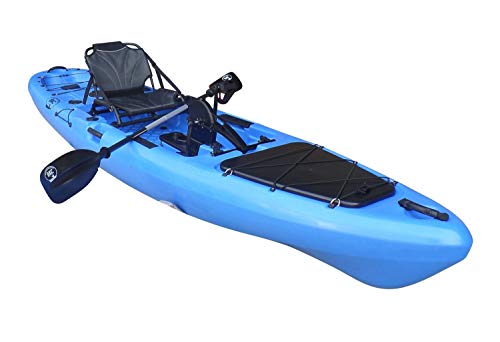How to Increase the Weight Capacity of a Kayak? 5 Ways
One of the most important factors to consider when selecting a kayak is the weight capacity, as it determines how much weight a kayak can carry, including the weight of the paddler, gear, and any other items that may be brought along.
But what happens when the weight capacity of your kayak is not enough to accommodate all the gear you need for your adventure?
Can the weight capacity of a kayak be increased, and if so, how to increase the weight capacity of a kayak?
You can increase the weight capacity of a kayak by evenly distributing weight, packing lighter gear, and adding flotation devices to increase buoyancy. However, it’s not recommended to modify the construction of the kayak as this can compromise its stability and, in turn, your safety.
Keep reading to learn more about whether you should increase the weight capacity of your kayak and how to do it in a safe manner.
Table of Contents
Is It Possible to Increase the Weight Capacity of a Kayak?

The weight capacity of a kayak refers to the maximum amount of weight that it can safely carry, including the weight of the paddler, gear, and any other items on board.
The weight capacity of recreational kayaks ranges from 250 to 350 pounds. However, this capacity may not be enough for some paddlers, which leads them to look for ways to increase the weight capacity of their kayaks.
While it is possible to increase the weight capacity of a kayak to some extent, you need to keep in mind that it’s not always a good idea, as there are some limitations and potential risks involved.
Before we get into how to increase the weight capacity of your kayak and whether you should do it, you first need to be aware of the factors that determine the weight capacity of any kayak.
Factors That Affect the Weight Capacity of a Kayak
The weight capacity of a kayak is determined by several factors, including:
- Hull shape and design: The hull shape and design can determine the stability and buoyancy of a kayak, which affects its weight capacity. For instance, a wider, flatter hull provides greater stability but may have a lower weight capacity than a narrower, more rounded hull.
- Materials: Kayaks made of lighter materials such as carbon fiber or kevlar may have a higher weight capacity than those made of heavier materials such as polyethylene.
- Weight distribution: The weight distribution of items within the kayak affects its overall stability and buoyancy. A kayak with a higher weight capacity may not necessarily be able to handle a heavier load if the weight is not distributed evenly.
- Accessories: The weight of any accessories added to the kayak, such as seats, footrests, and storage compartments, can also affect its weight capacity.
- Flotation devices: Flotation devices or buoyancy aids such as airbags or foam blocks can increase the weight capacity of a kayak.
Choosing the Right Weight Capacity When Purchasing a Kayak
When choosing the right weight capacity for your kayak, you need to consider your body weight as well as the weight of any gear or supplies you plan to bring,
First, take your body weight and add the weight of any clothing or gear you plan to wear while kayaking. Next, add the weight of any gear, supplies, or equipment you plan to bring with you.
Now, you just need to find a kayak with a weight capacity that exceeds the total weight you calculated. A good rule of thumb is to choose a kayak with a weight capacity that is at least 50 pounds more than the total weight you calculated.
If you’re looking for kayak recommendations, make sure to check out the guides listed at the end of this article; you’re guaranteed to find a kayak that suits your needs and your budget.
How to Increase the Weight Capacity of a Kayak?

Increasing the weight capacity of a kayak without compromising its stability can be challenging. However, there are some safe options you can consider:
- Use a Kayak with a Higher Weight Capacity: One of the easiest ways to increase the weight capacity of a kayak is to simply get a kayak with a higher weight capacity.
- It is important to note that a kayak with a higher weight capacity will typically be larger and heavier, so make sure to consider the transportation and storage limitations. It will also be more expensive, so make sure to plan your budget accordingly.
- Redistribute the Weight: Another way to increase the weight capacity of a kayak is to distribute the weight of items within the kayak evenly.
- Try to keep the heavier items closer to the center of the kayak and the lighter items towards the ends to maintain stability.
- Reduce Weight Load: It is also possible to increase the weight capacity of a kayak by reducing the weight load on board. This can be done by packing only the essentials and leaving behind any unnecessary items.
- Add Flotation Devices: Adding flotation devices, such as airbags or foam blocks, to the kayak can help increase its weight capacity.
- However, keep in mind that these devices should be properly installed and tested to ensure they do not affect the safety or stability of the kayak. If you’re not sure how to install the floating devices, it’s recommended to consult a professional.
- Upgrade Kayak Accessories: Upgrading the accessories of the kayak, such as seats, footrests, and storage compartments, to lighter ones can also help to increase the weight capacity.
Should You Increase the Weight Capacity of a Kayak?
Just because you can increase the weight capacity of your kayak doesn’t mean you should, especially if you intend to modify or significantly alter the construction of the kayak without professional help.
Kayaks are designed and tested to ensure their safety and stability under certain conditions, and that includes their weight capacity.
By altering the kayak’s construction, such as adding additional flotation devices or increasing the size of the kayak, you might compromise its structural integrity and stability, leading to a potentially dangerous situation on the water.
Furthermore, modifying a kayak can also void its warranty, leaving the kayaker without recourse in case of damage or malfunction.
So, if you want to increase your kayak’s weight capacity, it’s best to explore safer methods. It’s also essential to follow the manufacturer’s guidelines and avoid making any significant alterations or modifications that can impact its stability and safety on the water.
Kayaks with High Weight Capacity
As explained earlier, a better option than to try to increase the weight capacity of a kayak is to get a kayak with a high weight capacity to begin with.
There are plenty in the market to choose from, but here are the two options I like the best:
My top pick is this Brooklyn Kayak Company PK13 sit-on-top kayak. It’s an excellent choice for overweight individuals looking for a stable and comfortable kayak.
With a weight capacity of up to 550 pounds, it can easily accommodate larger paddlers. Additionally, the adjustable footrests and padded seat provide added comfort for extended paddling sessions.
The BOTE Zeppelin Aero Inflatable Kayak is another ideal choice for overweight individuals, especially those on a tighter budget.
The inflatable design makes it easy to transport and store, and the durable material can handle weights up to 500 pounds. The wide design also provides added stability and reduces the risk of capsizing.
Kayak your way to Freedom
- On a budget? Check out the best fishing kayaks under $500 here and the best Fishing Kayaks under $1,000 here. Or Check the best Cheap Kayaks here.
- Going fishing? Here are the best Ocean fishing kayaks, and here are the best River Fishing Kayaks.
- You can also find the best Fly Fishing Kayaks here and the best Bass Fishing Boats here.
- A bit experienced? Check out the best modular kayaks here and the best tandem fishing kayaks here.
- Looking for something special? Check out my favorite Ducky kayaks here.
- Navigate your way with these awesome and beginner-friendly Kayak compasses.
- Going Hunting? These Duck hunting kayaks will give you an unfair advantage!
- Have a need for speed? These motorized kayaks will get you moving.
- Protect yourself from the sun with these Kayak shades, and make your kayak more comfortable with these Kayak seats.
- Keep your feet dry and warm with these superb Kayaking shoes.
- Going Kayaking in cold water? Stay warm with these Kayaking gloves.
- Paddle Less, Fish More with the Best Kayak Motors
- Looking to get a trolling motor on your kayak? Check out the best kayak trolling motor mounts here.
If you like this article, please share it or pin it, you can find the share buttons below. We will really appreciate it ❤️










